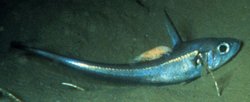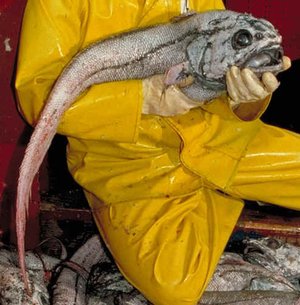Rattail
|
|
| Grenadiers or rattails | ||||||||||
|---|---|---|---|---|---|---|---|---|---|---|
 Rattail or grenadier (Macrouridae sp.) | ||||||||||
| Scientific classification | ||||||||||
| ||||||||||
| Genera | ||||||||||
|
Many; see text. |
Grenadiers or rattails (less commonly whiptails) are generally large, brown to black gadiform marine fish of the family Macrouridae. Found at great depths from the Arctic to Antarctic, members of this family are among the most abundant of the deep-sea fishes. Grenadiers are perhaps best known for their cameo in the blockbuster film Titanic, where the fish are glimpsed during ROV reconnaissance of the wreck.
The Macrouridae are a large and diverse family with some 34 genera and 383 species recognized. They range in length from approximately 10 centimetres in the graceful grenadier (Hymenocephalus gracilis) to 1.5 metres in the giant grenadier (Albatrossia pectoralis). An important commercial fishery exists for the larger species, such as the giant grenadier and roundnose grenadier (Coryphaenoides rupestris). The family as a whole may represent up to 15 per cent of the deep-sea fish population.
Typified by large heads with large mouths and eyes, grenadiers have slender bodies that taper greatly to a very thin caudal peduncle or tail (excluding one species, there is no tail fin): this rat-like tail explains the common name rattail and the family name Macrouridae, from the Greek makros meaning "great" and oura meaning "tail". The first dorsal fin is small, high and pointed (and may be spinous); the second dorsal fin runs along the rest of the back and merges with the tail and extensive anal fin. The scales are small.
As with many deep-living fish, the lateral line system in grenadiers is well-developed; it is further aided by numerous chemoreceptors located on the head and lips, and chemosensory barbels underneath the chin. Benthic species have gas bladders with unique muscles attached to them. The animals are thought to use these muscles to "strum" their gas bladders and produce sound, possibly playing a role in courtship and mate location. Light-producing organs called photophores are present in some species; they are located in the middle of the abdomen, just before the anus and underneath the skin.
Living at depths from 200 to 6,000 metres, rattails are the most common benthic fish of the deep (however, two genera are known to prefer the midwater). Rattails may be solitary or they may form large schools, as with the roundnose grenadiers. The benthic species are attracted to structural oases, such as hydrothermal vents, cold seeps, and shipwrecks. Rattails are thought to be generalists, feeding on smaller fish, pelagic crustaceans such as shrimp and amphipods, cumaceans and less often cephalopods and lanternfish. As well as being important apex predators in the benthic habitat, some species are also notable as scavengers.
As few rattail larvae have been recovered, little is known of their life history. They are known to produce a large number (over 100,000) of tiny (1-2 millimetres in diameter) eggs made buoyant by lipid droplets. The eggs are presumed to float up to the thermocline (the interface between warmer surface waters and cold, deeper waters) where they develop. The juveniles remain in shallower waters, gradually migrating to greater depths with age.
Spawning may or may not be tied to the seasons, depending on the species. At least one species (Coryphaenoides armatus) is thought to be semelparous; that is, the adults die after spawning. Non-semelparous species may live to 56 years or more. The Macrouridae in general are thought to have low resilience; commercially exploited species may be overfished and this could soon lead to a collapse of rattail fisheries.
See also: List of fish common names, list of fish families
Family Macrouridae
- Subfamily Bathygadinae
- Genus Bathygadus
- Genus Gadomus
- Subfamily Macrourinae
- Genus Albatrossia
- Genus Asthenomacrurus
- Genus Caelorinchus
- Genus Cetonurichthys
- Genus Cetonurus
- Genus Coryphaenoides
- Genus Cynomacrurus
- Genus Echinomacrurus
- Genus Haplomacrourus
- Genus Hymenocephalus
- Genus Hyomacrurus
- Genus Kumba
- Genus Kuronezumia
- Genus Lepidorhynchus
- Genus Lucigadus
- Genus Macrosmia
- Genus Macrourus
- Genus Malacocephalus
- Genus Mataeocephalus
- Genus Mesobius
- Genus Nezumia
- Genus Odontomacrurus
- Genus Paracetonurus
- Genus Pseudocetonurus
- Genus Pseudonezumia
- Genus Sphagemacrurus
- Genus Trachonurus
- Genus Ventrifossa
- Subfamily Macrouroidinae
- Genus Macrouroides
- Genus Squalogadus
- Subfamily Trachyrincinae
- Genus Idiolophorhynchus
- Genus Trachyrincus
External links
- FishBase entry on Macrouridae (http://filaman.uni-kiel.de/Summary/FamilySummary.cfm?ID=185)

